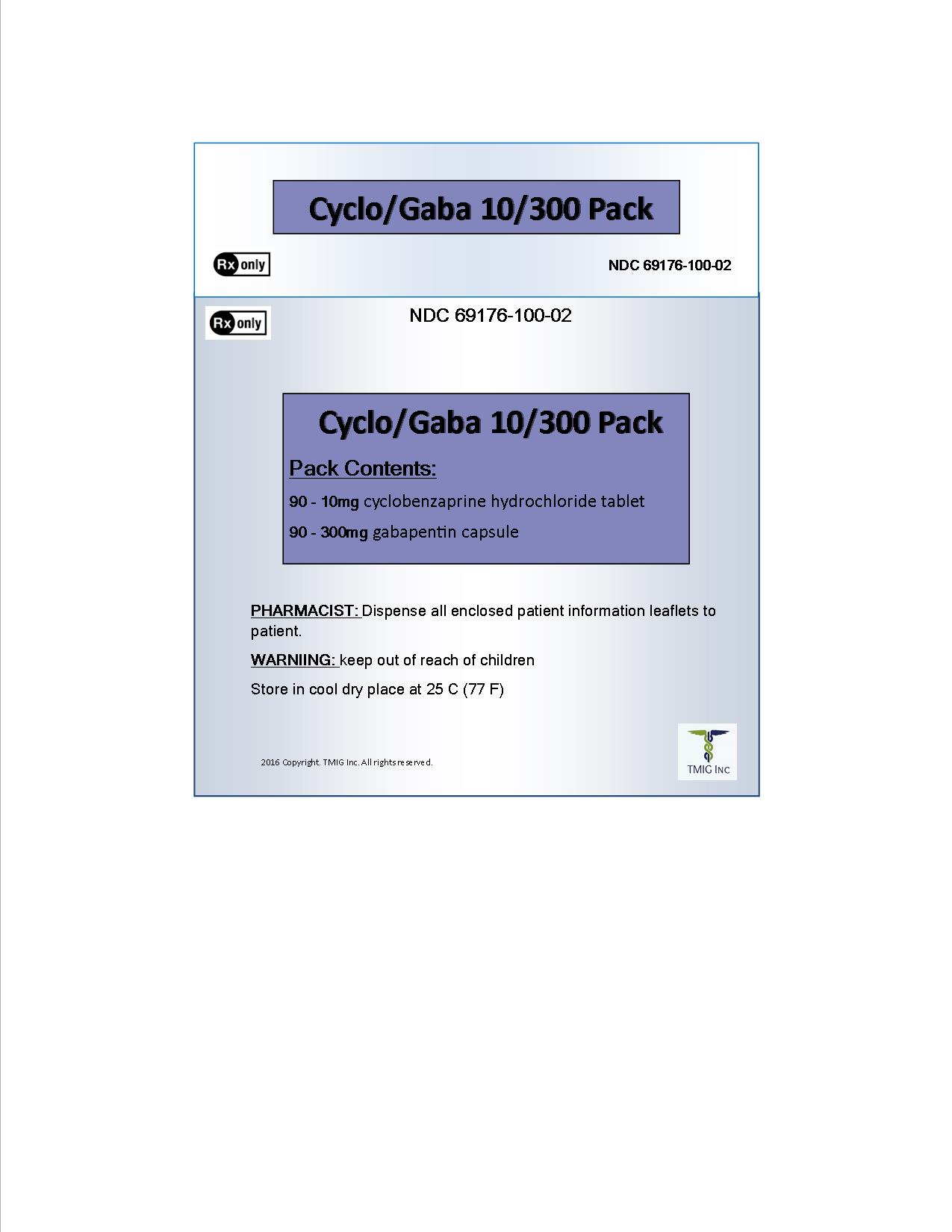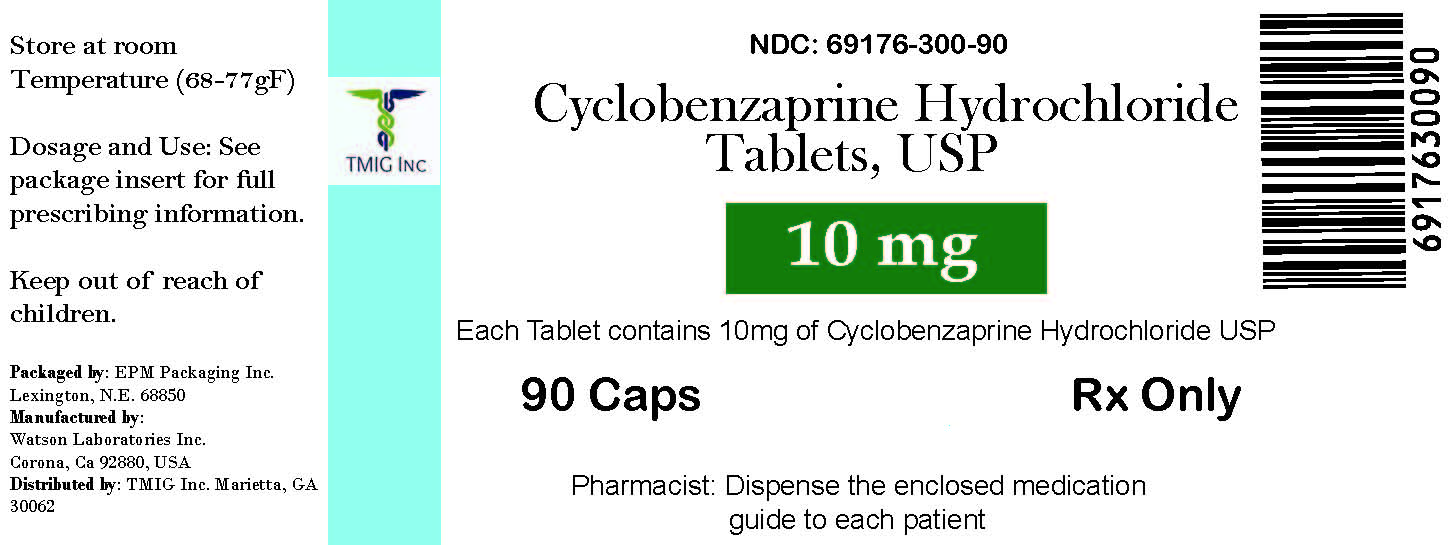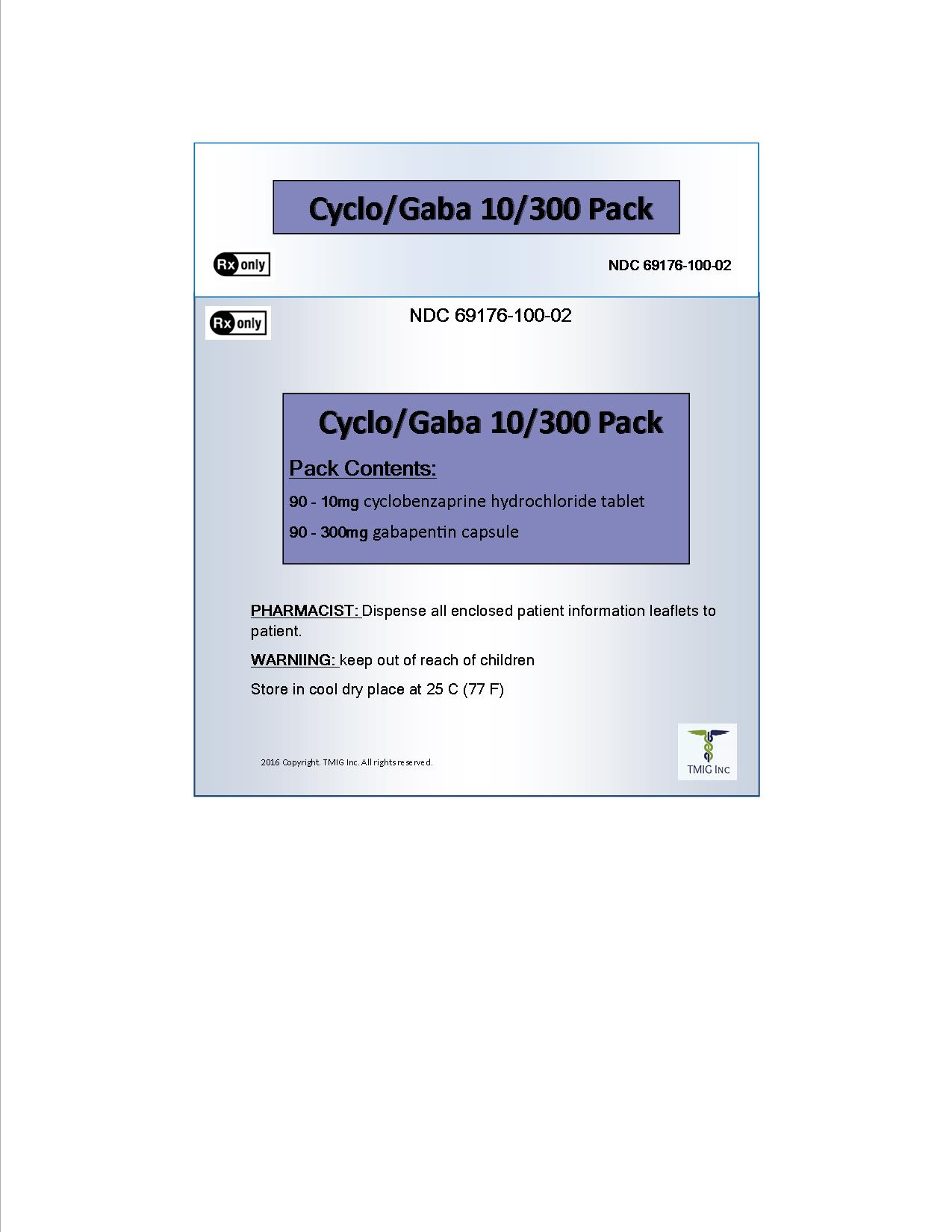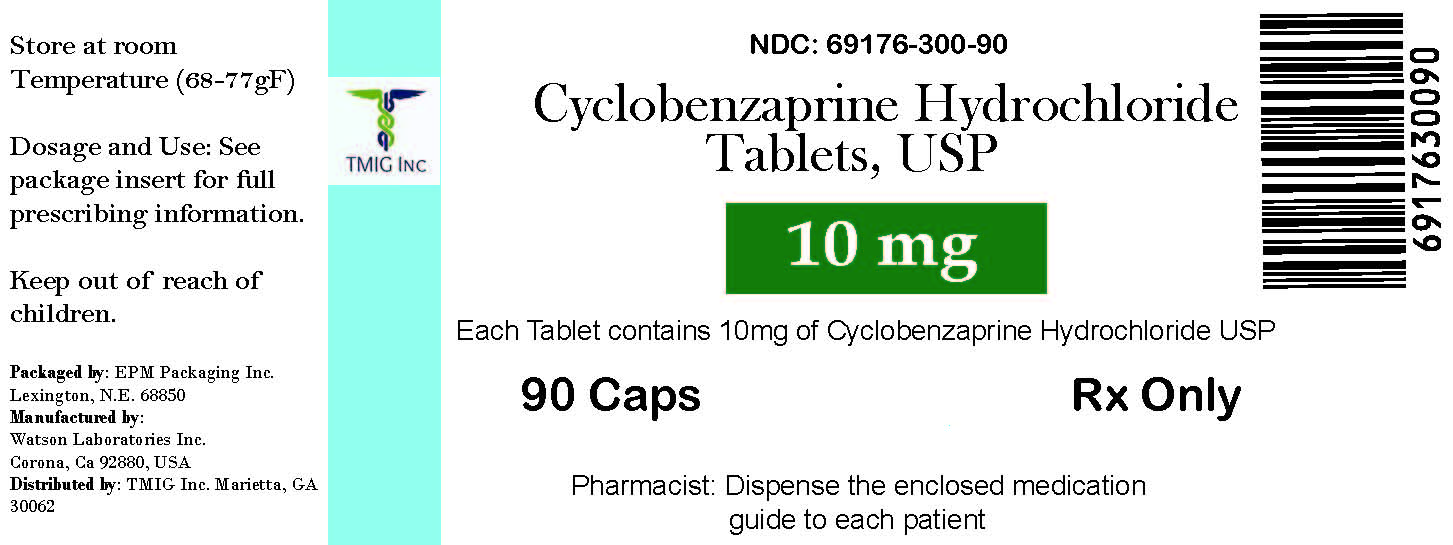Label: CYCLO/GABA 10/300 PACK kit
-
Contains inactivated NDC Code(s)
NDC Code(s): 69176-100-02 - Packager: TMIG Inc.
- This is a repackaged label.
- Source NDC Code(s): 67877-223
- Category: HUMAN PRESCRIPTION DRUG LABEL
- DEA Schedule: None
- Marketing Status: Abbreviated New Drug Application
Drug Label Information
Updated June 22, 2016
If you are a consumer or patient please visit this version.
- Download DRUG LABEL INFO: PDF XML
- Official Label (Printer Friendly)
- 4 CONTRAINDICATIONS
-
7 DRUG INTERACTIONS
7.1 Other Antiepileptic Drugs
Gabapentin is not appreciably metabolized nor does it interfere with the metabolism of commonly coadministered antiepileptic drugs [see Clinical Pharmacology (12.3)] .
7.2 Opioids
Hydrocodone
Coadministration of gabapentin with hydrocodone decreases hydrocodone exposure [see Clinical Pharmacology (12.3)]. The potential for alteration in hydrocodone exposure and effect should be considered when gabapentin is started or discontinued in a patient taking hydrocodone.
Morphine
When gabapentin is administered with morphine, patients should be observed for signs of central nervous system (CNS) depression, such as somnolence, sedation and respiratory depression [see Clinical Pharmacology (12.3)] .
7.3 Maalox® (aluminum hydroxide, magnesium hydroxide)
The mean bioavailability of gabapentin was reduced by about 20% with concomitant use of an antacid (Maalox ®) containing magnesium and aluminum hydroxides. It is recommended that gabapentin be taken at least 2 hours following Maalox administration [see Clinical Pharmacology (12.3)] .
7.4 Drug/Laboratory Test Interactions
Because false positive readings were reported withthe Ames N-Multistix SG ® dipstick test for urinary protein whengabapentin was added to other antiepileptic drugs, the more specificsulfosalicylic acid precipitation procedure is recommended to determine thepresence of urine protein.
-
9 DRUG ABUSE AND DEPENDENCE
9.2 Abuse
Gabapentin does not exhibit affinity for benzodiazepine, opiate (mu, delta or kappa), or cannabinoid 1 receptor sites. A small number of postmarketing cases report gabapentin misuse and abuse. These individuals were taking higher than recommended doses of gabapentin for unapproved uses. Most of the individuals described in these reports had a history of poly-substance abuse or used gabapentin to relieve symptoms of withdrawal from other substances. When prescribing gabapentin carefully evaluate patients for a history of drug abuse and observe them for signs and symptoms of gabapentin misuse or abuse (e.g. development of tolerance, self-dose escalation, and drug-seeking behavior).
9.3 Dependence
There are rare postmarketing reports of individuals experiencing withdrawal symptoms shortly after discontinuing higher than recommended doses of gabapentin used to treat illnesses for which the drug is not approved. Such symptoms included agitation, disorientation and confusion after suddenly discontinuing gabapentin that resolved after restarting gabapentin. Most of these individuals had a history of poly-substance abuse or used gabapentin to relieve symptoms of withdrawal from other substances. The dependence and abuse potential of gabapentin has not been evaluated in human studies.
-
10 OVERDOSAGE
A lethal dose of gabapentin was not identified in mice and rats receiving single oral doses as high as 8000 mg/kg. Signs of acute toxicity in animals included ataxia, labored breathing, ptosis, sedation, hypoactivity, or excitation.
Acute oral overdoses of gabapentin up to 49 grams have been reported. In these cases, double vision, slurred speech, drowsiness, lethargy, and diarrhea were observed. All patients recovered with supportive care. Coma, resolving with dialysis, has been reported in patients with chronic renal failure who were treated with gabapentin.
Gabapentin can be removed by hemodialysis. Although hemodialysis has not been performed in the few overdose cases reported, it may be indicated by the patients clinical state or in patients with significant renal impairment.
If overexposure occurs, call your poison control center at 1-800-222-1222.
-
12 CLINICAL PHARMACOLOGY
12.1 Mechanism of Action
The precise mechanisms by which gabapentin producesits analgesic and antiepileptic actions are unknown. Gabapentin is structurallyrelated to the neurotransmitter gamma-aminobutyric acid (GABA) but has noeffect on GABA binding, uptake, or degradation. In vitro studies haveshown that gabapentin binds with high-affinity to the α2δ subunit ofvoltage-activated calcium channels; however, the relationship of this bindingto the therapeutic effects of gabapentin is unknown.
- 13 NONCLINICAL TOXICOLOGY
- 14 CLINICAL STUDIES
-
16 HOW SUPPLIED/STORAGE AND HANDLING
Gabapentincapsules USP is supplied as follows:
100 mgcapsules:
White hardgelatin capsules imprinted “216” on body with blue ink, available in:
Bottles of 100:NDC 67877-222-01
Bottles of 500:NDC 67877-222-05
Bottles of1000: NDC 67877-222-10
300 mg capsules:
Yellow hardgelatin capsules imprinted “215” on body with blue ink, available in:
Bottles of 100:NDC 67877-223-01
Bottles of 500:NDC 67877-223-05
Bottles of1000: NDC 67877-223-10
400 mgcapsules:
Orange hardgelatin capsules imprinted “214” on body with blue ink, available in:
Bottles of 100:NDC 67877-224-01
Bottles of 500:NDC 67877-224-05
Bottles of1000: NDC 67877-224-10
Storage
Store at 20° to 25°C (68° to 77°F); [see USP Controlled Room Temperature].
-
17 PATIENT COUNSELING INFORMATION
Advise the patient to read the FDA-approved patient labeling (Medication Guide).
Drug Reaction with Eosinophilia and Systemic Symptoms (DRESS)/Multiorgan Hypersensitivity
Prior to initiation of treatment with gabapentin, instruct patients that a rash or other signs or symptoms of hypersensitivity (such as fever or lymphadenopathy) may herald a serious medical event and that the patient should report any such occurrence to a physician immediately [see Warnings and Precautions (5.1)] .
Anaphylaxis and Angioedema
Advise patients to discontinue gabapentin and seek medical care if they develop signs or symptoms of anaphylaxis or angioedema [ see Warnings and Precautions (5.2)].
Dizziness and Somnolence and Effects on Driving and Operating Heavy Machinery
Advise patients that gabapentin may cause dizziness, somnolence, and other symptoms and signs of CNS depression. Other drugs with sedative properties may increase these symptoms. Accordingly, although patients’ ability to determine their level of impairment can be unreliable, advise them neither to drive a car nor to operate other complex machinery until they have gained sufficient experience on gabapentin to gauge whether or not it affects their mental and/or motor performance adversely. Inform patients that it is not known how long this effect lasts [see Warnings and Precautions (5.3) and Warnings and Precautions (5.4)] .
Suicidal Thinking and Behavior
Counsel the patient, their caregivers, and families that AEDs, including gabapentin, may increase the risk of suicidal thoughts and behavior. Advise patients of the need to be alert for the emergence or worsening of symptoms of depression, any unusual changes in mood or behavior, or the emergence of suicidal thoughts, behavior, or thoughts about self-harm. Instruct patients to report behaviors of concern immediately to healthcare providers [see Warnings and Precautions (5.6)] .
Use in Pregnancy
Instruct patients to notify their physician if they become pregnant or intend to become pregnant during therapy, and to notify their physician if they are breast feeding or intend to breast feed during therapy [see Use in Specific Populations (8.1) and ( 8.3)] .
Encourage patients to enroll in the NAAED Pregnancy Registry if they become pregnant. This registry is collecting information about the safety of antiepileptic drugs during pregnancy. To enroll, patients can call the toll free number 1-888-233-2334 [see Use in Specific Populations (8.1)] .
This product’s label may have been updated. For full prescribing information, please visit www.dailymed.nlm.nih.gov.
Manufactured by:
Alkem Laboratories Limited
ALKEM HOUSE, Lower Parel,
Mumbai – 400 013, INDIA
Distributed by:
Ascend Laboratories, LCC
Montvale, NJ 07645
PT 1702-03 -
Medication Guide
Gabapentin Capsules USP
(GA ba PEN tin)
Read the Medication Guide before you start taking gabapentin and each time you get a refill. There may be new information. This information does not take the place of talking to your healthcare provider about your medical condition or treatment.
What is the most important information I should know about gabapentin?
Do not stop taking gabapentin without first talking to your healthcare provider.
Stopping gabapentin suddenly can cause serious problems.
Gabapentin can cause serious side effects including:
1. Suicidal Thoughts. Like other antiepileptic drugs, gabapentin may cause suicidal thoughts or actions in a very small number of people, about 1 in 500.
Call a healthcare provider right away if you have any of these symptoms, especially if they are new, worse, or worry you:
· thoughts about suicide or dying
· attempts to commit suicide
· new or worse depression
· new or worse anxiety
· feeling agitated or restless
· panic attacks
· trouble sleeping (insomnia)
· new or worse irritability
· acting aggressive, being angry, or violent
· acting on dangerous impulses
· an extreme increase in activity and talking (mania)
· other unusual changes in behavior or mood
How can I watch for early symptoms of suicidal thoughts and actions?
· Pay attention to any changes, especially sudden changes, in mood, behaviors, thoughts, or feelings.
· Keep all follow-up visits with your healthcare provider as scheduled.
Call your healthcare provider between visits as needed, especially if you are worried about symptoms.
Do not stop taking gabapentin without first talking to a healthcare provider.
· Stopping gabapentin suddenly can cause serious problems. Stopping a seizure medicine suddenly in a patient who has epilepsy can cause seizures that will not stop (status epilepticus).
· Suicidal thoughts or actions can be caused by things other than medicines. If you have suicidal thoughts or actions, your healthcare provider may check for other causes.
2. Changes in behavior and thinking -Using gabapentin in children 3 to 12 years of age can cause emotional changes, aggressive behavior, problems with concentration, restlessness, changes in school performance, and hyperactivity.
3. Gabapentin may cause a serious or life-threatening allergic reactions that may affect your skin or other parts of your body such as your liver or blood cells. This may cause you to be hospitalized or to stop gabapentin. You may or may not have a rash with an allergic reaction caused by gabapentin. Call a healthcare provider right away if you have any of the following symptoms:
· skin rash
· hives
· difficulty breathing
· fever
· swollen glands that do not go away
· swelling of your face, lips, throat, or tongue
· yellowing of your skin or of the whites of the eyes
· unusual bruising or bleeding
· severe fatigue or weakness
· unexpected muscle pain
· frequent infections
These symptoms may be the first signs of a serious reaction. A healthcare provider should examine you to decide if you should continue taking gabapentin.
What is gabapentin?
Gabapentin is a prescription medicine used to treat:
· Pain from damaged nerves (postherpetic pain) that follows healing of shingles (a painful rash that comes after a herpes zoster infection) in adults.
· Partial seizures when taken together with other medicines in adults and children 3 years of age and older with seizures.
Who should not take gabapentin?
Do not take gabapentin if you are allergic to gabapentin or any of the other ingredients in gabapentin. See the end of this Medication Guide for a complete list of ingredients in gabapentin.
What should I tell my healthcare provider before taking gabapentin?
Before taking gabapentin, tell your healthcare provider if you:
· have or have had kidney problems or are on hemodialysis
· have or have had depression, mood problems, or suicidal thoughts or behavior
· have diabetes
· are pregnant or plan to become pregnant. It is not known if gabapentin can harm your unborn baby. Tell your healthcare provider right away if you become pregnant while taking gabapentin. You and your healthcare provider will decide if you should take gabapentin while you are pregnant.
o If you become pregnant while taking gabapentin, talk to your healthcare provider about registering with the North American Antiepileptic Drug (NAAED) Pregnancy Registry. The purpose of this registry is to collect information about the safety of antiepileptic drugs during pregnancy. You can enroll in this registry by calling 1-888-233-2334.
· are breast-feeding or plan to breast-feed. Gabapentin can pass into breast milk. You and your healthcare provider should decide how you will feed your baby while you take gabapentin.
Tell your healthcare provider about all the medicines you take, including prescription and over-the-counter medicines, vitamins, and herbal supplements.
Taking gabapentin with certain other medicines can cause side effects or affect how well they work. Do not start or stop other medicines without talking to your healthcare provider.
Know the medicines you take. Keep a list of them and show it to your healthcare provider and pharmacist when you get a new medicine.
How should I take gabapentin?
· Take gabapentin exactly as prescribed. Your healthcare provider will tell you how much gabapentin to take.
o Do not change your dose of gabapentin without talking to your healthcare provider.
o Take gabapentin capsules with water.
If you take too much gabapentin, call your healthcare provider or your local Poison Control Center right away at 1-800-222-1222.
What should I avoid while taking gabapentin?
· Do not drink alcohol or take other medicines that make you sleepy or dizzy while taking gabapentin without first talking with your healthcare provider. Taking gabapentin with alcohol or drugs that cause sleepiness or dizziness may make your sleepiness or dizziness worse.
· Do not drive, operate heavy machinery, or do other dangerous activities until you know how gabapentin affects you. Gabapentin can slow your thinking and motor skills.
What are the possible side effects of gabapentin?
Gabapentin may cause serious side effects including:
See “What is the most important information I should know about gabapentin?”
· problems driving while using gabapentin. See “What I should avoid while taking gabapentin?”
· sleepiness and dizziness, which could increase the occurrence of accidental injury, including falls
· The most common side effects of gabapentin include:
· lack of coordination
· feeling tired
· viral infection
· fever
· feeling drowsy
· jerky movements
· nausea and vomiting
· difficulty with coordination
· difficulty with speaking
· double vision
· tremor
· unusual eye movement
· swelling, usually of legs and feet
Tell your healthcare provider if you have any side effect that bothers you or that does not go away.
These are not all the possible side effects of gabapentin. For more information, ask your healthcare provider or pharmacist.
Call your doctor for medical advice about side effects. You may report side effects to FDA at 1-800-FDA-1088.
How should I store gabapentin?
· Store gabapentin Capsules between 20° to 25°C (68° to 77°F); [see USP Controlled Room Temperature].
Keep gabapentin and all medicines out of the reach of children.
General information about the safe and effective use of gabapentin
Medicines are sometimes prescribed for purposes other than those listed in a Medication Guide. Do not use gabapentin for a condition for which it was not prescribed. Do not give gabapentin to other people, even if they have the same symptoms that you have. It may harm them.
This Medication Guide summarizes the most important information about gabapentin. If you would like more information, talk with your healthcare provider. You can ask your healthcare provider or pharmacist for information about gabapentin that was written for healthcare professionals.
What are the ingredients in gabapentin?
Active ingredient: gabapentin
Inactive ingredients in the capsules: anhydrous lactose, cornstarch, and talc. The 100-mg capsule shell also contains: gelatin, sodium lauryl sulfate, and titanium dioxide.
The 300-mg capsule shell also contains: gelatin, sodium lauryl sulfate, titanium dioxide, and yellow iron oxide.
The 400-mg capsule shell also contains: gelatin, sodium lauryl sulfate, red iron oxide, titanium dioxide, and yellow iron oxide. The imprinting ink contains shellac, dehydrated alcohol, isopropyl alcohol, butyl alcohol, propyl glycol, strong ammonia solution, and titanium dioxide.
Manufactured by:
Alkem Laboratories Limited
ALKEM HOUSE, Lower Parel,
Mumbai – 400 013, INDIA
Distributed by:
Ascend Laboratories, LCC.
Montvale, NJ 07645
Revised October 2015
PT 1702-03 - DESCRIPTION
- PACKAGE LABEL.PRINCIPAL DISPLAY PANEL
-
INGREDIENTS AND APPEARANCE
CYCLO/GABA 10/300 PACK
cyclo/gaba 10/300 pack kitProduct Information Product Type HUMAN PRESCRIPTION DRUG Item Code (Source) NDC:69176-100 Packaging # Item Code Package Description Marketing Start Date Marketing End Date 1 NDC:69176-100-02 1 in 1 KIT; Type 1: Convenience Kit of Co-Package 07/01/2016 Quantity of Parts Part # Package Quantity Total Product Quantity Part 1 1 Part 2 1 Part 1 of 2 CYCLOBENZAPRINE HYDROCHLORIDE
cyclobenzaprine hydrochloride tablet, film coatedProduct Information Item Code (Source) NDC:69176-300 Route of Administration ORAL Active Ingredient/Active Moiety Ingredient Name Basis of Strength Strength CYCLOBENZAPRINE HYDROCHLORIDE (UNII: 0VE05JYS2P) (CYCLOBENZAPRINE - UNII:69O5WQQ5TI) CYCLOBENZAPRINE HYDROCHLORIDE 10 mg Inactive Ingredients Ingredient Name Strength SILICON DIOXIDE (UNII: ETJ7Z6XBU4) CROSCARMELLOSE SODIUM (UNII: M28OL1HH48) CALCIUM PHOSPHATE, DIBASIC, ANHYDROUS (UNII: L11K75P92J) CELLULOSE, MICROCRYSTALLINE (UNII: OP1R32D61U) HYDROXYPROPYL CELLULOSE (TYPE H) (UNII: RFW2ET671P) HYPROMELLOSES (UNII: 3NXW29V3WO) POLYETHYLENE GLYCOLS (UNII: 3WJQ0SDW1A) MAGNESIUM STEARATE (UNII: 70097M6I30) TITANIUM DIOXIDE (UNII: 15FIX9V2JP) Product Characteristics Color white Score no score Shape ROUND Size 8mm Flavor Imprint Code DAN;5658 Contains Marketing Information Marketing Category Application Number or Monograph Citation Marketing Start Date Marketing End Date ANDA ANDA071611 06/23/2016 Part 2 of 2 GABAPENTIN
gabapentin capsuleProduct Information Item Code (Source) NDC:69176-200(NDC:67877-223) Route of Administration ORAL Active Ingredient/Active Moiety Ingredient Name Basis of Strength Strength GABAPENTIN (UNII: 6CW7F3G59X) (GABAPENTIN - UNII:6CW7F3G59X) GABAPENTIN 300 mg Inactive Ingredients Ingredient Name Strength STARCH, CORN (UNII: O8232NY3SJ) ANHYDROUS LACTOSE (UNII: 3SY5LH9PMK) TALC (UNII: 7SEV7J4R1U) GELATIN (UNII: 2G86QN327L) SODIUM LAURYL SULFATE (UNII: 368GB5141J) FERRIC OXIDE YELLOW (UNII: EX438O2MRT) TITANIUM DIOXIDE (UNII: 15FIX9V2JP) Product Characteristics Color yellow Score no score Shape CAPSULE Size 19mm Flavor Imprint Code 215 Contains Marketing Information Marketing Category Application Number or Monograph Citation Marketing Start Date Marketing End Date ANDA ANDA090858 07/01/2016 Marketing Information Marketing Category Application Number or Monograph Citation Marketing Start Date Marketing End Date ANDA ANDA090858 01/29/2011 Labeler - TMIG Inc. (036572986) Registrant - TMIG Inc (036572986) Establishment Name Address ID/FEI Business Operations TMIG Inc. 036572986 repack(69176-100) , manufacture(69176-100) Establishment Name Address ID/FEI Business Operations EPM Packaging, Inc 079124340 repack(69176-200)






